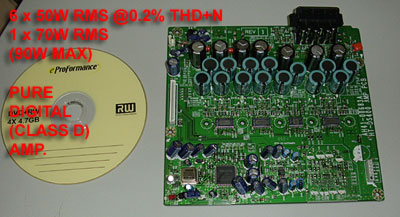Maybe you noticed, that new home cinema systems, LCD/Plasma screens, receivers have very small amplifiers. Physically small. But the power output is quite big. And there is no big, heavy heatsinks on these devices. And no big transformers. At a first glance I thought that all this output power is represented in “Chinese wats”. But in this case, the wats are real. And these devices are using “digital” D-class amplifiers.
What a hell is D-Class amplifier? It is old-new invention- digital amplifier. “Digital” means only one bit 🙂 The analog output is made using pulse width modulation (PWM) output. Some sound is converted to digital form using CPU ar special chips and this PWM sygnal is fed to powerfull MOSFETS. Real DAC conversion is made on small inductors near the output.
Here is image of one such amp:

I removed small heatsink from the top of chips. There is no need for big heatsinks as efficiency of such amp is about 90% (acording datasheet).

Here is closeup of the PCB. Note the size of SMD resistors and compare to the size of the chips. Chip is TAS5111 and TAS5112 made by Texas Instruments.
TAS5111 is buwoofer driver. Output of the chip is 70W RMS (@ 0,2% THD+N), 95dB dynamic range. And all this for single polarity 30V PSU (3.3V for logic). Other chip, TAS5112 is stereo amp (two channels) 2 x 50W (@ 0,2% THD+N).
The principle of operation is very simple. PWM sygnal from sound processor is fed to the chip. The chip is driving output mosfets in H-Bridge connection. As there are two PWM channels, the output is connected in full bridge. The chip is full of various protection circuits. All DAC is made on quite small 10uH coils (blue cylinders on PCB).
All amp is 6+1. Total 370W RMS from board sized like a CD box. Heat sink need to sink only 40W of heat during max load!
This particular board is damaged, I didn’t examined what is bad is this PCB, I picked up this PCB for weblog ilustration only.
